Introduction
Ellora Caves represent a monumental complex of rock-cut temples, monasteries, and shrines spanning Hindu, Buddhist, and Jain traditions, showcasing remarkable architectural and artistic achievements.
Ellora Caves: Architectural Marvels, and Historical Significance
- Location: It is located in the Aurangabad district, 100km away from Ajanta.
- It is excavated from the basalt cliffs in the Charanandri Hills.
- Numbers: It is a group of 34 caves – 17 Brahmanical, 12 Buddhist and 5 Jain. [UPSC 2013]
- Time Period: These caves were developed between the 5th and 11th centuries AD (newer as compared to Ajanta caves).
- Themes: They have diversity in terms of theme and architectural styles.
- Features: Their pillars are massive. Ajanta also has excavated double-storeyed caves but at Ellora, the triple-storey is a unique achievement.
Enroll now for UPSC Online Course
Buddhist Caves of Ellora: Icons, Symbolism, and Serenity
- Images: The shrine Buddha images are big in size; they are generally guarded by the images of Padmapani and Vajrapani.
- The Buddhist caves have many images belonging to Vajrayana Buddhism, like Tara, Mahamayuri, Akshobya, Avalokiteshwara, Maitreya, Amitabha etc.
- Central Figure: The central figure is Buddha, found in three sagacious postures: meditating (dhyana mudra), preaching (Vyakhyana mudra) and touching the earth by the index finger of the right hand (bhumi-sparsha mudra).
- Buddhist caves represented goddesses by way of the carved images of Tara, Khadiravani-tara, Chunda, Vajradhat-vishvari, Maha-mayuri, Sujata, Pandara and Bhrikuti.
Jaina Caves
- Figures of Yaksha-matanga, Mahavira, Parsvanatha, and Gomatesvara
Cave Temples of Vedic Religions: Exploring Kailasanatha and Beyond
- The earliest caves in these groups are modest and simple. Mostly, they are square-shaped except for the Kailasanatha cave (cave-16).
| Kailasanatha Temple (Cave-16)
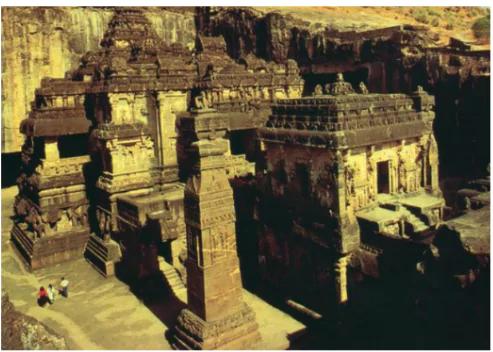
- It is a monolithic structure, carved out of a single solid rock. This temple is said to represent Kailash, the abode of Lord Shiva.
- The temple was built by Krishna I (756-773 AD) of the Rashtrakuta Dynasty.
- The temple is two-storied, and the Kailasa temple is on the first one.
- The lower storey has carved life-size elephants, which look like they are holding up the temple on their backs.
- The temple exterior has images of Shaivite and Vaishnavite deities.
- The courtyard has two huge pillars with the flagstaff and a Nandi mandapa.
- The wedding ceremony of Siva-Parvati, the attempted lifting of the Kailash mountain by Ravana, and the destruction of Mahishasura by the goddess Durga are beautiful sculptures.
- An interesting sculpture is that of the river goddess Ganga mounted on a crocodile and the river goddess Yamuna mounted on a tortoise.
- Among the Shaivite themes, Ravana shaking Mount Kailash, Andhakasurvadha, and Kalyanasundara are profusely depicted, whereas among the Vaishnavite themes, the different avatars of Vishnu are depicted.
|
Some Of The Prominent Caves Of Ellora
| CAVE NO |
FEATURES |
| Cave 10 |
- Vishwakarma Cave or Carpenter’s Cave.
- Buddha seated in Dharmachakra Mudra with a Bodhi tree carved at his back.
|
| Cave 12 |
- A stout female figure is depicted wearing a waistband and headgear of a cobra.
- Khadrivani-tara also holds a cobra in one of her hands in the same cave.
|
| Cave-14 |
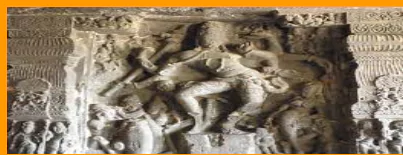
Ravan ki Khai Cave |
| Cave 15 |
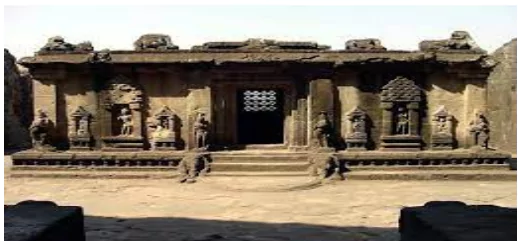
|
| Cave 29 |
|
| Cave 30 |
- Chhota Kailash (Jain cave)
|
| Cave 32 |
|
| Cave 33 |
- Jagannath Sabha (Jain cave)
|
Enroll now for UPSC Online Classes
Prominent Cave Sites: Elephanta, Bagh, Junagadh, Mandapeshwar, and Udayagiri
Elephanta Caves (mid-5th to 6th centuries AD)
- Location: It is located on Elephanta Island (otherwise known as the Island of Gharapuri) near Mumbai and was originally a Buddhist site, later dominated by the Shaivite faith.
- Timeline: It is contemporary with Ellora, and it is famous for its sculptures.
- It is a UNESCO World Heritage site.
- Mixed Caves: It has Five Hindu caves and a pair of Buddhist caves.
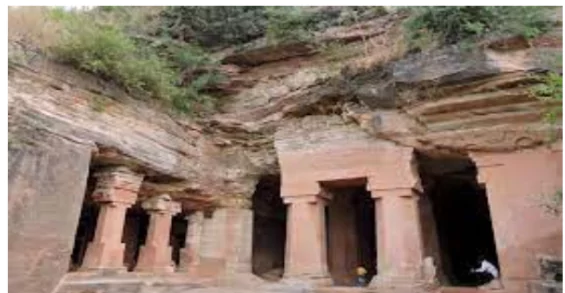 The most important cave is the Maheshmurti cave.
The most important cave is the Maheshmurti cave.
Bagh Caves
- Location: It is located on the banks of Baghni River in Dhar district of Madhya Pradesh and is a group of nine Buddhist caves.
- Period: It was developed around 5th-6th century AD, mostly during the Satvahana period.
- The most significant cave is the Rang Mahal.
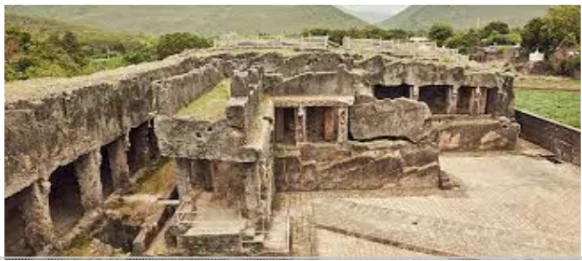
Junagadh Cave
- Its unique feature is the presence of a 30-50 ft high citadel known as ‘Upar kot’ in front of the prayer hall.
Mandapeshwar Caves (Borivali near Mumbai):
- They are also known as Montperir Caves.
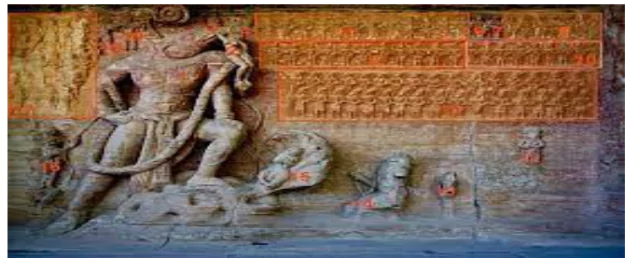 Developed in the late Gupta period as a Brahmanical cave and was later converted into a Christian cave.
Developed in the late Gupta period as a Brahmanical cave and was later converted into a Christian cave.
Udayagiri Caves (Different from Udayagiri – kandagiri caves of Odisha)
- Location: It is located in Vidisha, Madhya Pradesh and created in the early 5th century AD under the patronage of Chandragupta II.
Conclusion
- Ellora Caves epitomize the harmonious coexistence of diverse religious traditions and the extraordinary craftsmanship of ancient India, serving as a testament to the region’s rich cultural heritage and spiritual legacy.
![]() June 7, 2024
June 7, 2024
![]() 6500
6500
![]() 0
0


 The most important cave is the Maheshmurti cave.
The most important cave is the Maheshmurti cave.
 Developed in the late Gupta period as a Brahmanical cave and was later converted into a Christian cave.
Developed in the late Gupta period as a Brahmanical cave and was later converted into a Christian cave.